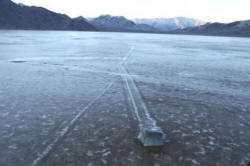|
 Scientists
solve mystery of moving Death Valley rocks Scientists
solve mystery of moving Death Valley rocks
 Send a link to a friend
Send a link to a friend
[August 29, 2014]
By Alex Dobuzinskis
LOS ANGELES (Reuters) - A solution to the
longstanding mystery of why rocks move erratically across an isolated
patch of California's Death Valley finally emerged on Thursday, when
researchers published a study showing the driving force was sheets of
wind-driven ice.
|
|
 Trails from the movement of the rocks, which show them changing
direction suddenly in their movement across the so-called Racetrack
Playa, have long befuddled scientists and the general public. People
wondered: How were the rocks moved? Trails from the movement of the rocks, which show them changing
direction suddenly in their movement across the so-called Racetrack
Playa, have long befuddled scientists and the general public. People
wondered: How were the rocks moved?
Paleobiologist Richard Norris of the Scripps Institution of
Oceanography, who led the study, saw the rare phenomenon first-hand
last December while standing with his cousin, engineer James Norris,
at the spot.
They published their findings on Thursday in the journal PLOS One,
showing that even though the stones can sit for a decade or more
without moving, on certain occasions they go on a slow trip that
results from an unusual combination of ice and wind in an area
normally known for scorching hot temperatures.

That happens when the dry lake bed they are in freezes over with a
thin layer of ice which then breaks apart in a light wind, sending
large sheets of ice against the rocks with enough force to move them
a few yards per minute, Norris said.
Because of the ability of the large ice sheets to catch the wind,
and aided by the underlying flow of water, the rocks, which weigh as
much as 700 pounds (318 kg), are pushed along in a way that could
not occur from the force of the wind alone, he said.
A scientific theory dating back to the 1950s had suggested that
thick ice and heavy winds could be behind the movement of the rocks,
but the study published on Thursday found the ice is far thinner and
the wind much lighter than first thought.
[to top of second column]
|

Popular theories for what drives the rocks have ranged from a sudden
tilting of the Earth to the action of giant magnets under the
surface of the ground.
"I think it has massive popular appeal because it is one of these
things that’s very widely known about but kind of marveled at,”
Norris said.
Norris said other people might have seen the rare phenomenon of
wind-driven ice pushing the Death Valley rocks, but they probably
did not understand what they were seeing because it happens so
slowly and the trail the rocks leave is obscured until the water
dries out.
His team used motion-activated GPS units built into rocks and also
cameras to document the phenomenon in preparation for publishing
their findings.
(Reporting by Alex Dobuzinskis)
[© 2014 Thomson Reuters. All rights
reserved.] Copyright 2014 Reuters. All rights reserved. This material may not be published,
broadcast, rewritten or redistributed.
 |